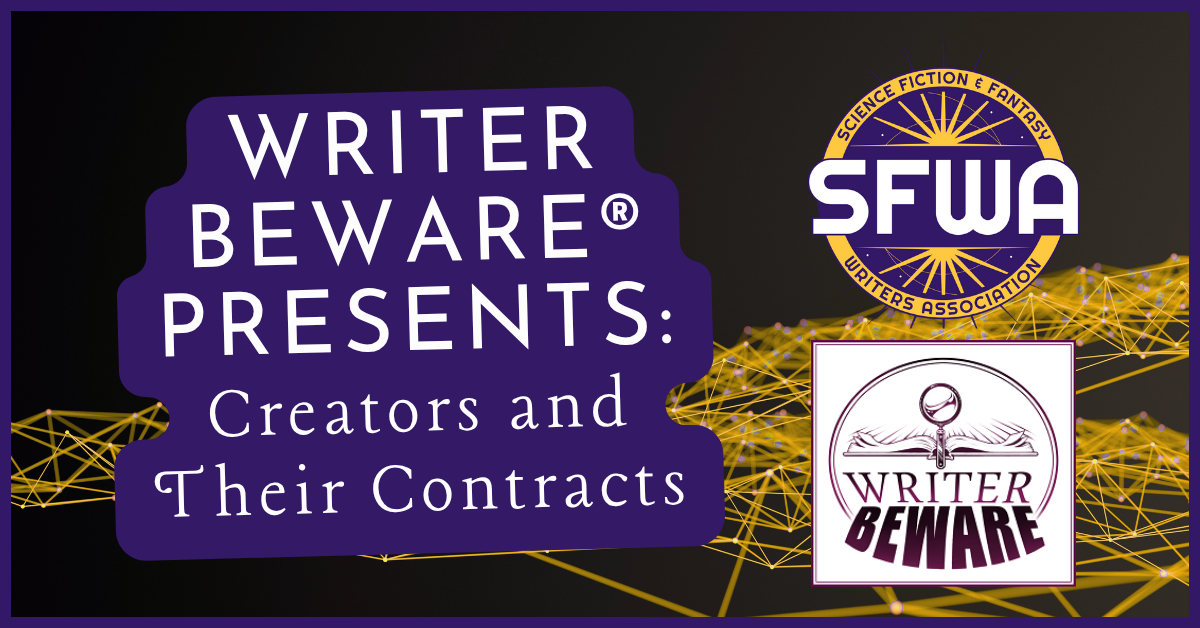A Word from Our Contracts Committee…
Moral Rights Clauses are currently being discussed by the Contracts Committee. Please see this recent post from Writer Beware® for additional context. The Contracts Committee always welcomes samples of current SFF contracts, sent to contracts@sfwa.org with the author’s identifying information removed. Stay informed, and let other writers know to read their contracts carefully!
As directed by the SFWA Board, the purpose of the Contracts Committee is to:
- Update and maintain the existing SFWA contract templates;
- Work to develop and maintain a repository of sample contracts and contract-related information;
- Work to educate members about contract language and recommendations;
- Work to help SFWA and its members answer contract related questions and issues.
The Contracts Committee leads SFWA discussion regarding contract terms. The committee prepares and updates annotated model publishing contracts that provide an explanation of contract clauses and what to watch out for. It issues alerts about dangerous contract terms and provides publishing contract analysis. Committee members have a vast experience with contracts of all types and will privately review contracts either with or without personal information redacted. Email contracts@sfwa.org for more information or with questions or issues.
Model Contracts and Contract Information
SFWA has produced model contracts since it was created in 1965. The first, a Model Author-Agent Agreement written by SFWA founder Damon Knight, appeared in the first issue of the SFWA Bulletin in July, 1965. The model contracts are intended to help writers understand publishing contracts and to help them negotiate better contracts. They are not intended to be and should not be understood to be legal advice. For legal advice, you should consult a competent attorney familiar with the business of publishing as well as the law of the applicable jurisdiction.
Versions and Formatting of Model Contracts
SFWA’s model contract are arranged with the text of the contract on the left with the Contracts Committee’s notes explaining the contract on the right. By including detailed notes, the Committee is working to increase the educational value of the model contracts.
The contracts will be modified from time to time, with most changes being minor changes in wording as work on later contracts leads to language that will improve earlier contacts. Minor changes will be identified by the version number following the decimal point. (e.g. 3.0 followed by 3.1 and then by 3.2)
Model Reversion Clause, Version 1.1As part of its ongoing efforts to educate writers about publishing contracts, the Contracts Committee periodically writes new model contracts and contract clauses. We have now done so for book reversion clauses. Address comments or suggestions to the Chair, SFWA Contracts Committee at: contracts@sfwa.org. The model reversion clause is based on work done by SFWA’s Contracts Committee and Writer Beware over a number of years. The members of the Contracts Committee who worked on this model clause were: Jim Fiscus, (Chair), Michael Capobianco, Rosemary Claire Smith, Ginjer Buchanan, Jeff Hecht, Anne Leonard, Ken Liu, advisor and, Victoria Strauss, advisor. James Beamon was SFWA Board liaison to the Committee. The model clause was written as a generic guide to writers, and it is not intended to be and should not be used as boilerplate in contracts by publishers, writers, or agents, and any such use is not approved by SFWA. Further, any such use be should not be cited as being approved by SFWA. Use of this model clause by a publisher does not automatically make sales to that market eligible to be used as credentials for SFWA membership. Legal Disclaimer: Neither the model reversion clause nor the comments thereto are intended to be or should be understood to be legal advice. The issues presented in the model clause are not an exhaustive list of the issues that may arise, and other important issues may need to be addressed depending on the nature of the relationship of the parties, the jurisdiction that you are contracting in and other factors. As with any legal document, you should consult a competent attorney familiar, in this case, with the business of publishing as well as the law of the applicable jurisdiction for legal advice. |
Model Agent-Author Agreement, Version 3.1Traditionally, writers have worked with agents on the basis of a handshake. SFWA has, however, long believed that writers need the protection of a written agreement. The latest re-working of SFWA’s model agent agreement is more detailed than the previous version so it can address specific problems writers have had in recent years. |
Model Anthology Contract, Version 3.0Version 3.0 is a long overdue revision of SFWA’s 1989 Model Anthology Contract. |
Model Author Collaboration Agreement, Version 1.0The following is SFWA’s model Author Collaboration Agreement. As part of its continuing effort to educate writers about publishing contracts, the Contracts Committee periodically writes new sample contracts and updates old sample contracts. Address comments or suggestions to the Chair, SFWA Contracts Committee at contracts@sfwa.org. The model agreement is based on a collaboration agreement written by writer and filmmaker James A. Conrad. The members of the Contracts Committee who worked on the 2017 revision of the contract were: Michael Capobianco, Jim Fiscus (chair), Ginjer Buchanan, Jeff Hecht, Ken Liu, Rosemary Smith, and Anne Leonard. SFWA Director-at-Large Lawrence Schoen served as an ex-officio member of the Committee. |
Model Magazine Contract, Version 3.1The latest version of the Model Magazine Contract is an update of the 1997 version of the contract, revised to reflect changes in the industry, including the growth of electronic publications. |
Intro to Publishing ContractsThis 34 page .pdf document by Sean P. Fodera and C. E. Petit provides an overview to publishing contracts.
|
Voice Actor Model Contracts
Contract Committee Note Regarding Voice Actors—
Some months ago, a SFWA member was hiring a voice actor to produce an audio book, but could not find contracting advice. The actor was a member of the Screen Actors Guild-American Federation of Television and Radio Artists (SAG-AFTRA,) but even the Union did not have a model contract for the situation. SFWA’s Legal Fund made a grant to the member so she could obtain legal advice.
The contract and letter of agreement posted here were worked out by her lawyer with the actor and SAG-AFTRA. The SFWA Contracts Committee is posting both the contract and the letter of agreement with SAG-AFTRA here as a guide for writers.
If the actor you are hiring is not a member of SAG-AFTRA, then the letter of agreement would not apply. Also, the sections of the contract that deal with SAG-AFTRA — in blue italics — would not be part of a contract.
Download Agreement Letter PDF | RTF
Download Voice Talent Services Contract PDF | DOC
Contracts Committee Alerts
- Legal Affairs Alert on the New Zealand National Library
- Legal Affairs Committee Alert: CASE Act on Copyright Small Claims Becomes Law
- SFWA Contracts Committee Advisory on No-advance Contracts
- Contracts Committee Alert – Failure to Finalize Contracts
- Contracts Committee Alert – Copyright Class Action suit payments
Contracts Committee News
- Legal Affairs Committee Alert: CASE Act on Copyright Small Claims Becomes Law
- SFWA Releases a New Model Magazine Contract
- Contracts Committee Report

